AZZA Genesis 9000 Case Review: Building It Every Way
by Dustin Sklavos on July 13, 2012 4:15 AM EST- Posted in
- Cases/Cooling/PSUs
- ATX
- AZZA
Noise and Thermal Testing, Stock
Since the AZZA Genesis 9000 has no front intake fans, intake cooling duties are handled largely by the two bottom-mounted 140mm fans. Bottom-to-top cooling can be very effective, but the motherboard isn't rotated ninety degrees here the way it is in SilverStone's more efficient designs, so air travelling through the Genesis 9000 unfortunately just doesn't have a very efficient default path to work with.
I tested the Genesis 9000 in its stock tray orientation (with the motherboard tray flipped and the video card above the CPU) and with the tray oriented in the typical ATX style (with the CPU above the video card); these are listed as "default" and "alt" respectively. The case's fan control also only has two speeds, low and high, and so I tested it in each of these speeds for a combined four different test runs. Ambient temperature around the Genesis 9000 varied between 24C and 25C during testing.

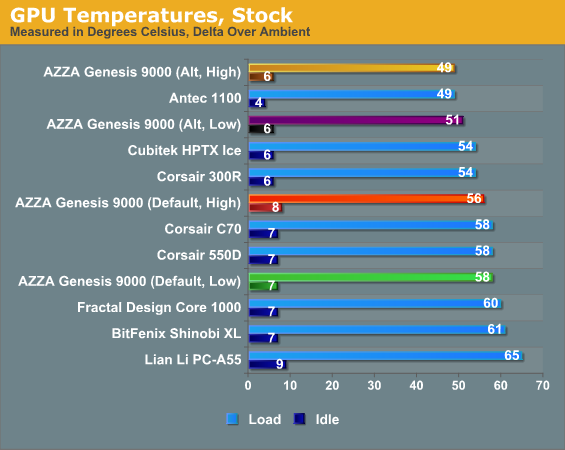
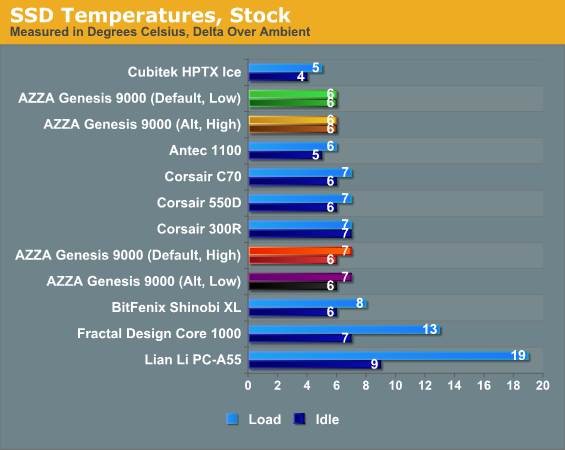
Thermally the Genesis 9000 puts in a solid performance. Unfortunately there's no one-size-fits-all orientation; if you run it in its stock configuration, the graphics card runs hotter but the CPU heatsink gets fed. If you flip the tray, suddenly the graphics card is getting fed but the CPU heatsink is blocked somewhat by the video card. In our non-overclocked configuration, though, we can easily determine that switching between low nad high fan speeds doesn't seem to have much of an effect. This isn't surprising; most cases tend to perform perfectly fine with their fans running low-to-mid speeds and gain very little by pumping up the fan speed.
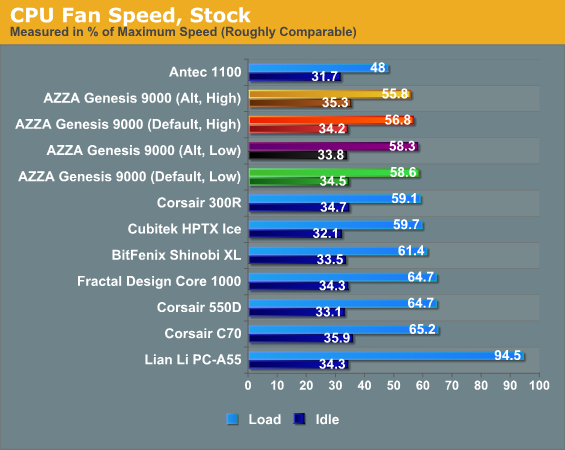
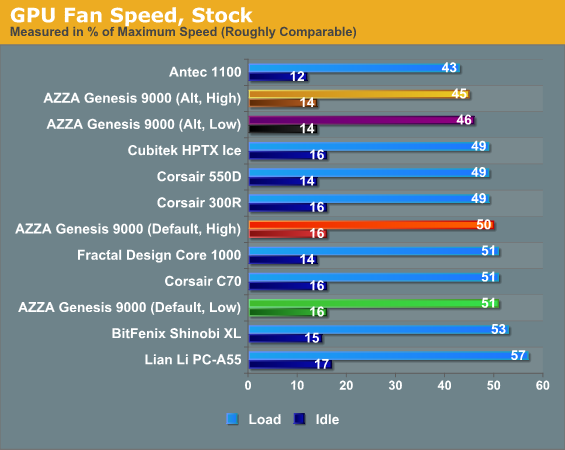
Fan speeds for the most part tell the same story. Depending on the motherboard orientation, you're really feeding one or the other, and I can see this becoming a real problem in a multi-GPU configuration. Under those circumstances you may want to consider installing a 200mm intake fan in the side panel.
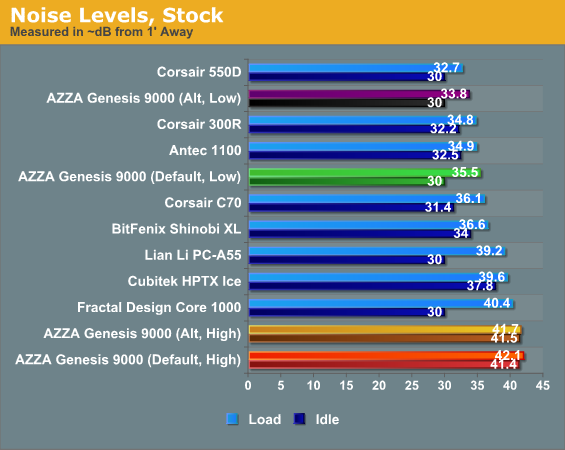
While bumping up the case's fan speed doesn't seem to do much for its thermals, it makes the whole thing nearly unbearable to listen to. There's virtually no reason to run the Genesis 9000 at high speed.
Also note that the standard ATX orientation of the motherboard (listed as "alt") runs a bit quieter. This makes sense when you consider that high performance graphics cards typically draw more power and generate more heat than CPUs do. We're looking at a 95W CPU competing with a 170W GPU; under the circumstances cooling the GPU should probably take priority, and that's why the default orientation may not actually be the right call.










30 Comments
View All Comments
Grok42 - Saturday, July 14, 2012 - link
I too agree that it would be nice to see cases reviewed with min and max setup options, I can only imagine this would take forever. I work on a social site and we have a guy that does reviews which we participate as additional testers. It takes an enormous amount of time to test and this is for simple things like specialized towels and other non-configurable equipment.I not exactly sure of your exact point about 5.25" bays Vs 3.5" bays but I think you and I are of the same opinion. I posted a long screed about this in the last case review that wasn't very popular. Basically 5.25" bays are pretty useless. There are almost no internal 5.25" accessories on the market anymore other than CD/DVD/Blue-Ray drives which you pointed out you only need one of. Other than possibly using one for an optical drive, the rest of the bays, while providing plenty of room for cooling, are also a waste of space.
lwatcdr - Tuesday, July 17, 2012 - link
"Basically 5.25" bays are pretty useless. There are almost no internal 5.25" accessories on the market anymore other than CD/DVD/Blue-Ray drives which you pointed out you only need one of.Actually you are mistaken their. I admit that the huge number of 5 1/4 "drive bays in this case is a bit odd but they are used a lot in custom rigs for water cooling which this case looks like it was really set up for.
For example here is a page of Bay reservoirs for water cooled rigs.
http://www.frozencpu.com/cat/l3/g30/c97/s168/list/...
Some come with pumps as well.
With this case you could put a rather large rad in the top and an smaller one in the bottom for a dual loop set up. Two large pumps and reservoirs would take up 4 bays.
You also have something like this http://www.newegg.com/Product/Product.aspx?Item=N8...
Which lets you mount 31/2" drives in two 5 1/2 bays and have them be hot swappable so one could in mount 16 hot swappable drives in this case for a storage server. Or any combination of or drives you could want.
There you go . I am sure you can see ways now to fill them with a high end water cooled rig.
Dustin Sklavos - Friday, July 13, 2012 - link
You seriously can't tell that the hard drives are going to be spaced well apart? Even after I specifically mention that the drive trays actually kind of waste space because it's basically one drive per 5.25" bay?We're a long, long way from the old days of horrible 3.5" hard drive cramping.
P5-133XL - Friday, July 13, 2012 - link
The vast majority of internet reviews are non-critical specifically designed to sell the product. Is because there is a potential problem with HD temps and that's why they didn't include them? We don't know, for they didn't test.There are lots of cases where that info is known so there are lots of alternatives so this case is not needed but if they want to review a case then they should do a good job and include important data such as this.
P5-133XL - Friday, July 13, 2012 - link
Sorry about the grammar/editing error.I wish to reword the sentence "Is because there is a potential problem with HD temps and that's why they didn't include them?" to be "Is there a potential problem with HD temps and that is why they were not included?
MilwaukeeMike - Friday, July 13, 2012 - link
"Bottom-to-top cooling can be very effective, but the motherboard isn't rotated ninety degrees here the way it is in SilverStone's more efficient designs, so air travelling through the Genesis 9000 unfortunately just doesn't have a very efficient default path to work with."If I remember right, some website did a compare of Silverstone's alignment to other cases rotated at 90 degress and found that rotating your case (or mobo inside it) made no difference in temps.
I'm surprised this case isn't quieter, I wonder if the fans could be replaced by slower/quieter fans. As the results show, increasing the speed doesn't help much, so maybe it could be lowered.
Dustin Sklavos - Friday, July 13, 2012 - link
The point I was making wasn't that the convection design isn't what makes SilverStone's designs work, it's the fact that the coolers for the CPU and GPU are completely unobstructed in their 90-degree rotated designs. There's just a straight shot from the fans right into the coolers, while here either the CPU fan or the GPU fan is being prioritized.MilwaukeeMike - Friday, July 13, 2012 - link
Found some other pics online of this case... the top looks very cool, you should throw in some pics of it.Sabresiberian - Friday, July 13, 2012 - link
Very nice to see another case acknowledging the fact that larger mainboards exist, and multiple-GPU rigs need space to support them all. I would have preferred to see a 10-slot capability over 9-slot, but definitely a step in the right direction.;)
BlueHighway - Friday, July 13, 2012 - link
I've been considering this case since I noticed it about a week ago. I was hoping for good results in this review, but now I'm not so certain... For one thing, my video card is the hottest component in my case (GTX 580), so I'll have to rotate the motherboard to the normal position - and I was under the impression that this alternative "flipped" design was supposed to be superior for GPU cooling!A minor thing I'm disappointed about is that the blue-teal LEDs will not be illuminated except when fans are at maximum speed, which I will probably never have... Unless maybe I can replace the stock fans with my Noctuas and keep them running at high speed.
Quick question - 25" is the maximum height of the case, and as some of us keep computer cases under our desks, how much of an impact would a 3"-4" clearance above the case have on the overall airflow? I assume 25" is the maximum height, as the top is rounded, and the lowest points are maybe 23", so there's going to be more clearance in those areas.